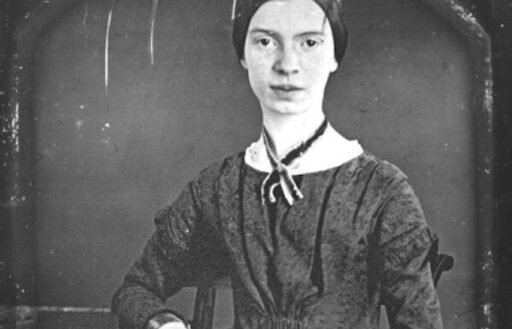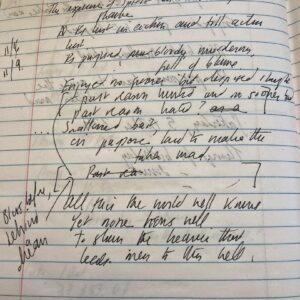Students know lots of poems—songs from Disney films, lyrics written by Taylor Swift and other popular composers and performers, songs from Broadway musicals, hymns sung at church, Beatles tunes, rap and hip-hop….
But that’s not the same thing as the poetry that students are assigned to read and write about in college courses. The authors and titles in the big anthologies, spanning the centuries: many students don’t know what to do, what to say in class discussion. For them, reading this kind of poetry is mysterious and intimidating. It’s a challenge for me as a teacher—trying to give students the skills that will help them to take delight and find illumination in poetry, enjoying it through coming to understand and appreciate it, the emotional and intellectual benefits it offers.
I don’t have great wisdom to pass along in this post, just some suggestions that have worked for me when my students and I are getting underway on day one.
In the fall 2023 semester, I began with a poem by Emily Dickinson, dated 1862—my text is from the edition by R. W. Franklin (1998):
I like a look of Agony, Because I know it’s true— Men do not sham Convulsion, Nor simulate, a Throe— The eyes glaze once—and that is Death— Impossible to feign The Beads upon the Forehead By homely Anguish strung.
I ask students to look at the poem: what do they see? I mean literally see. There’s hesitation, nervousness. They suspect there’s a secret I’m assuming they will detect if they peer into the poem.
I call on someone, “So, Susan, what do you see?” With luck, Susan will answer, “Well, it’s not very long.” To which I reply, “Excellent!”
This gets us started, they loosen up. Some students raise their hands, and I call on them and on others who look doubtful or apprehensive. I want them to see and say that this poem has no title, that it’s short, two stanzas, and is presented in short lines. Dickinson is writing in the first person, and some of the words she has given to this voice are plain and common, a single syllable, while others are more unusual, three or four syllables, sorts of words we don’t often use or hear in conversation.
Now it’s time for the students to speak the lines. We begin with the first four words, “I like a look”: a simple phrase, first-person, alliteration, ever-so-slightly casual—it’s not “the look,” but “a look.” The tone is direct, austere, yet on the edge of being jaunty, colloquial. I want us to hear this phrase, as all of us practice becoming (as Robert Frost counsels) ear readers as well as eye readers.
Next, I invite several students to take turns saying the full line: “I like a look of Agony.” They feel the impact of the three-syllable word as it arrests the movement of the succinct one-syllable words that precede it.
I bring a dictionary to the classroom every day, and it enables me to make explicit the definition of “Agony.” The word derives from the Greek agōnia, from agōn, “contest.” It’s extreme physical or mental suffering, the final stages of a difficult or painful death. For Dickinson, “Agony” is a choice, as are her choices to capitalize it, place it at the end of the first line, and follow it with a comma. She could have selected a different word, with a different etymology and meanings. But this is the word she wanted.
“I like a look of Agony, / Because I know it’s true—”: these lines are blunt, candid, and unnerving, not heightened in diction but still somewhat shocking. Dickinson’s speaker takes pleasure in being present when a person is in grievous pain. Other observers may not know, but she knows, that a look of Agony is true. The implication is that people mask or veil who they are, but that drastic suffering reveals the reality. A person in agony is helpless, prone on a bed, no defenses. For someone in the know like this discerning speaker, it’s a gratifying event, a powerless person’s self-disclosure. The speaker’s voice is authoritative, a commanding presence, an onlooker who is and always will be there.
I ask the students to glance ahead. Are any of the words odd or strange? There’s “Throe,” for example. Half-rhyming here with “true,” it comes from Old English thrēa, thrawu , “calamity,” and it is commonly used in the plural “throes,” intense or violent pain and struggle, accompanying birth, death, or significant change, a violent spasm or pang, such as convulses the body, limbs, or face, as in he was in great pain in his death throes. Here again, I aim for the class to be attentive to Dickinson as a choice-making literary artist, selecting this word, what it means and how it feels (its texture), placing it in this line, this stanza.
Where are the verbs? Like, know, is (it’s), sham, simulate, glaze, is, feign, strung. We see and hear these choices—as in the terrific, condensed power of “sham” as it thrusts into the multi-syllabic “Convulsion.” And in the next stanza, the tight, vivid phrase, “The eyes glaze once,” the fourth word halting and highlighting the second and third words whose similar sounds have united them.
“I like a look of Agony” is intense and disquieting. But I also prompt students to catch the tough playfulness, the gleams of grim wit in, for instance, the final line’s “homely Anguish.” “Homely” connotes a person who is unattractive in appearance; it also evokes a place or surrounding that is simple yet cozy and comfortable. “Anguish” is personified, as if this figure were an attendant in the death chamber, positioning spots of sweat on the forehead of the deceased like threaded pieces of glass or stone in a necklace or rosary.
I want everyone to savor the force of “Anguish” and the sound bridge from its second syllable to the “s” in “strung.” “Anguish” is on the outside as it arranges the beads of sweat. At the same time, these beads signify the emanation from the inside out of the human being whose false face has disintegrated.
On day one, then, the takeaway for my students is that they turned out to be more equipped to read “I look a look of Agony” than they realized. There’s no reason for them to fear this poem or to feel at a distance from it. It’s there to be seen and heard and understood more fully through close reading and collaborative inquiry.
William E. Cain is Mary Jewett Gaiser Professor of English at Wellesley College, where he enjoys teaching courses on Ralph Waldo Emerson, Henry David Thoreau, and other American writers. His recent publications include essays on Edith Wharton and Ernest Hemingway.





